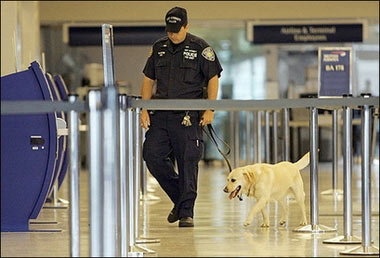More and more US police dogs are enjoying similar protection as their human
partners in fighting crime.

A Port Authority police officer with police
dog patrols the British Airways terminal in 2005 at JFK Airport in New
York. Prompted by the shooting death of a local police dog last year, an
anonymous donor in the city of Glendale, 16 kilometers (10 miles) north of
Los Angeles, gave funds to bulletproof the four dogs of his community's
K-9 unit.[AFP] |
The latest group are the dogs of one Southern California town who will be
strutting the streets this week with the new bulletproof vests.
Prompted by the shooting death of a local police dog last year, an anonymous
donor in the city of Glendale, 16 kilometers (10 miles) north of Los Angeles,
gave funds to bulletproof the four dogs of his community's K-9 unit.
"People tend to think that the police and the military use dogs as something
expendable, but we don't believe that at all," Sargeant Tom Lorenz of the
Glendale Police Department told AFP.
Police dogs are trained for narcotics investigations, search and rescue,
explosive detection, and to track and catch suspects.
"Our dogs increase our efficiency," said Lorenz. "They save us countless man
hours in search situations where we can send in one of our dogs with their keen
sense of smell."
Last week, one of the Glendale dogs' sharp nose sniffed out half a million
dollars of opium during a routine traffic stop. The 21-month-old German Shepherd
named "Yudy" was hailed with the biggest opium bust ever in the city.
At a time when police departments across the United States are experiencing
increasing difficulty wooing new recruits into careers in law enforcement,
trained dogs are valuable tools.
"We are all hurting for recruitment, we all would like more police officers,
but the dogs definitely make things easier, and they will all be equipped with
kevlar protection," said Lorenz.
Because police budgets are limited, funds for canine units often come from
private citizens and community groups. Concerned citizens in Glendale have
raised 96,000 dollars for the crime fighting dogs.
The money will be used to feed and care for the dogs, as well as outfit the
patrol cars with specialized air conditioning units, said Lorenz.
"We are lucky to have a community that supports its police force," he added.
"Many urban communities don't want dogs on the street, but here they are buying
us the dogs."
Ron Lieberman of Black Armor, a Southern California based manufacturer of
kevlar protective gear, has made contracts with a dozen police forces in the
United States.
"Sales of dog vests have been steady in the last few years," Lieberman told
AFP. "The animals normally get the lowest priority on the budget, so most of our
sales are through concerned school groups and private citizens."
According to the North American Police Dog Association, only about 10 percent
of US police canine units have the budget to buy bulletproof dog vests.
In 1999, Stephanie Taylor, an eleven-year-old from Oceanside, California
began a campaign to outfit police dogs with protective gear after she heard of
the shooting of a dog in the line of duty.
Through donations and fundraisers, her group called "Vest-A-Dog" has suited
over a thousand police dogs across the country.
But law enforcement analyst Charlie Mesloh believes that these canine unit
shooting deaths are rare, and may have given rise to an irrational
bulletproofing phenomena.
"These incidents tapped into the emotional reservoir of a nation," he wrote
in the FBI Law Enforcement Bulletin. He cautioned that there is no research on
how effective these vests are, and no reports of the armor actually having saved
a dog.
But the four German Shepherds of the Glendale police department today join
the legions of lucky law enforcement dogs that have been elevated to armored
status.
"They are members of the police family and also viewed in the same context as
the officers," Glendale Police canine unit commander Rodney S. Brooks.
"They come to work and spend a full day in the field, they have
responsibilities, they take, risks, just like their human
counterparts."